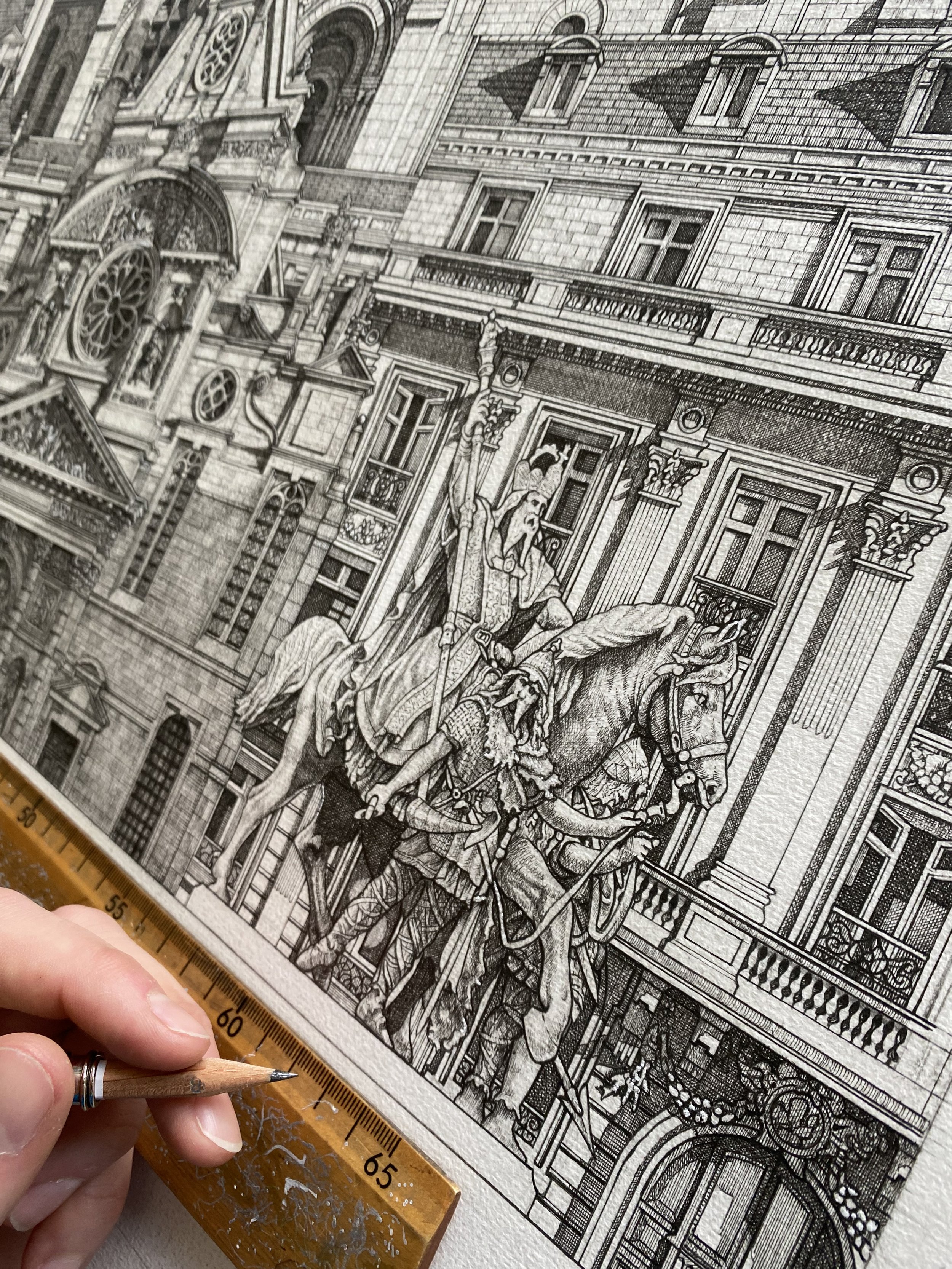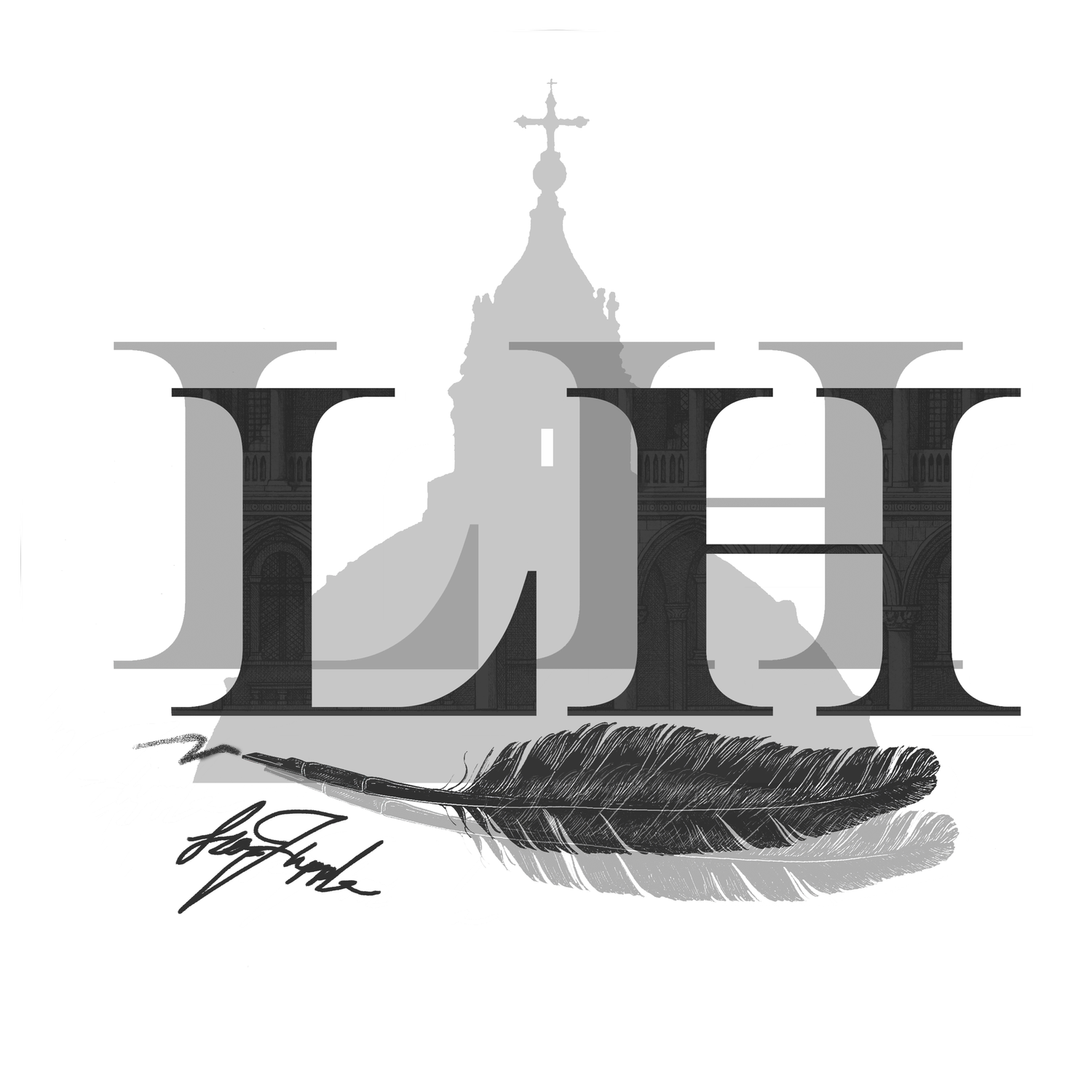PARIS COMPOSITE PROJECT
ORIGINS OF THE PARIS COMPOSITE
At the beginning of this year I was approached by several companies interested in collaborating on a new project on an entirely new and ambitious scale. The projects main objective was to create a large continuous illustration that could also be divided into three separate illustrations for multiple commercial uses. We decided upon Paris being the subject of the work and it would be a composite/elevation image. The drawing would comprise of a series of Parisian facades with iconic sculptures strategically dispersed throughout to add focal points and areas of interest.
It was agreed the drawing would be 230cm X 122cm(7.5ft X 4ft) which is four times larger than my current largest work. With those elements of the project decided it was now time to consider which Parisian buildings and figures would be included in the composite. This area of the project allowed me the most creative freedom. It was decided the Basilique du Sacre-Coeur, Eiffel Tower and Les Invalides would each individually dominate their given section of the composition, this would allow each section once divide into three to have a large central focal point. It was then a process of selecting which buildings would be featured and where they would be placed in the composite.
I began this process by considering what I imagine when thinking of Paris. My initial thoughts went to the chaotic Revolutionary period and the drastic changes that occurred throughout France and specifically Paris in this time, not just architecturally but politically and culturally. This led me to the Hotel de Ville, the city hall of Paris witnessed some of the most consequential scenes in history including the numerous popular uprisings in the earliest days of the Revolution. It also housed The Committee of Public Safety and became one of the French Revolution’s strategic bases. I then decided to included the Conciergerie the former medieval Royal residence which was converted into a political prison in the height of the Terror. It’s most famous prisoner was Marie Antoinette. The facade includes the stunning Clock Tower. The tower is a late medieval contraction and is the Conciergerie tallest tower it also houses Paris’s first public clock. This clock was installed on the eastern façade of the tower in 1371. Covered in gold leaf and decorated with beautiful blue mantle dotted with fleurs-de-lis. There are many facades that have strong tires to the Revolution or were conceived as a consequence of it. Such as the Arc de Triomphe, Les Invalides and the Vendome Column all of which are included.
I then turned to the period prior to the Revelation for inspiration. The Ancien Regime which divided society into three estates. The 1st estate comprised of the church and the clergy, the 2nd was dominated by the Nobility and the 3rd was the commoners . The King was the tip of the pyramid with absolute authority. I decided to adopted the three estates structure when choosing which buildings would be included. The church would take up a significant portion of the budlings for several reasons, as the 1st estate it’s responsibilities were vast. Naturally it was responsible for the nations spiritual and religious health it was also the main administrative center for many centuries. keeping records of births, deaths, marriages, baptisms and much more. Other responsibilities included education and distribution of charity to the poor. The various church’s, cathedrals and Basilica’s of Paris our also visually stunning with a wide range of architectural styles. Locations included are, Notre Dame Cathedral, Basilique du Sacre-Coeur, Tour Saint-Jacques, Saint-Étienne-du-Mont and the Church of Saint-Sulpice. The main sculptures representing the 1st estate are the two saints of Pairs, Saint Denis & Saint Genevieve. Both representing the blue and red of the Tricolore flag. These are the two largest sculptures in the illustration and will bookend either side of the composite.
The 2nd Estate is naturally harder to represent with one of the main goals of the Revelation being to eradicate this entire class including any visual representations including architectural monuments. I decided upon the Place des Vosges as a way of representing the nobility. Its the oldest planned city square in Paris and the second oldest in Europe. The square was often the place for the nobility to chat, and served as a meeting place for them, the square also held occasional equestrian activities. I decided to represent the nobility in sculptural form by including statues of France’s most successful Kings who resided over one of Frances golden ages. With a strong King and a prosperous kingdom the nobility would play a key role in assisting the king both in court and on the battle field. Louis XIV also known as the Great or Sun King reigned from1643 until his death in 1715. Louis XIV chose the sun as his personal emblem. The sun is the symbol of Apollo, god of peace and the arts. I’ll also be including royal and noble coats of arms throughout the illustration to represent the 2nd estate.
For the 3rd estate which comprises of all those not included in either of the other estates were known collectively as the commoners and bourgeoisie. This was by far the largest group with 98% of the French population despite their numbers they wielded the least power. It was an incredibly diverse group including, merchants, educated bourgeoisie, skilled artisans, and illiterate peasants. French clergymen Abbe Sieyes’ description as the Third Estate being “everything” is certainly justified. This group of many individuals would usually go unrecorded in history however there our some notable exceptions that have played a pivotal role in French and Parisian History.
I’ve included medieval Parisian Étienne Marcel who was Provost of the Merchants of Paris in the 1350s. As the representative of the 3rd estate in the Estates General he distinguished himself in the defense of the small craftsmen and various guilds through out Paris which was a significant percentage of the population at the time. Along with his equestrian statue there will be a collection of Parisian guild signs to reflect his achievements in protecting those who built and lived in Paris over the centauries. This then leads us onto the Patrion saint of France the Maid of Orléans, Joan of Arc. A rural peasant girl who rose to prominence during the hundred years war. She played a vital role in the fight against the English in securing Charles VII coronation and reversing the poor military and political situation the French found themselves in. Her image as a freedom fighter and defender of France has been evoked by the people to the present day. She came to symbolize a united France after the revelation and a symbolic leader in the feminist movement and the fight for equal rights.
Prior to the revelation those in the hierarchy of the 3rd estate could still accumulate wealth and power and have a huge impact on society. This includes lawyers, artists, musicians and merchants. Voltaire the son of a minor lawyer became one of the most influential enlightenment writers of his day. Most of his works were considered highly controversial and divisive to his peers however much of his theories and predictions would eventually come to fruition once the revelation was underway. He was a direct inspiration for many revolutionaries. The Voltaire statue mysteriously disappeared from the public back in 2021 however it has now been restored.
Finally we come to the most famous and infamous Frenchmen Napoleon Bonaparte. Although coming from a family of minor nobility in Corsica his family was considered part of the 3rd estate within the French structure once Corsica was folded into the Kingdom of France in 1768. An artillery officer who rose through the ranks during the early years of the Revolution and an early supporter of the Jacobins. Through military might and political intrigue Napoleon eventually become first consul in 1799 and then eventually the first Emperor in 1804 turning the former Republic into an Empire. Napoleons legacy is powerful and long lasting, considered the best general of his generation. He’s also highly credited for The Napoleonic Code, the civil code gave post-revolutionary France its first coherent set of laws concerning property, colonial affairs, the family and individual rights which is still in use today. Napoleon is featured in the illustration in the from of the Vendome Column, His coronation relief on the Arc De Triomf and the statue of Napoleon 1st overlooking the Cour d’Honneur at the Invalides.
Architecturally I decided the best way to represent the 3rd estate would be to include Parisian residential facades. They’re some of the most unique and beautiful examples in all of Europe. In the illustration they act as a bridges to the various larger facades like the churches and monumental buildings. They’re the cement that binds the composition together aswell as adding more detail to be discovered as you explore the work.
Other elements of the illustration don’t necessarily fit into the the 3 estates structure. These are buildings and sculptures are of cultural and artistic importance. The louvre the national art museum of Paris originally a late medieval palace it is now one of the most famous museums in the world. Housing some of the most canonical pieces of western art. The Pavillon de l'Horloge western wing facade will be included in the illustration. Sculptures from the museum, including the Venus de Milo, The Thinker, Louis XVI equestrian statue and the Winged Victory of Samothrace. The Palais Garnier considered the most famous opera house in the world completed in 1875 drew inspiration from many different styles including baroque, classical Palladio and Renaissance architecture. It was designed by Charles Garnier.
The Pont Alexandre III bridge which spans the Seine linking the Champs-Élysées quarter with those of the Invalides and Eiffel Tower. In the illustration it will cover the bottom portion of the illustration from St Denis on the left to St Genevieve on the right completing and unifying all three sections of the composition. Other sculptures include the La Défense de Paris a memorial to those who died in the defense of Paris during the Franco-Prussian war. Various statues on the roof of the Louvre and sculptures on the facade of Notre Dame.






PARIS COMPOSITE PRE-ORDER
Below is a link to the pre-order of the Paris Composite illustration. The prints will be a series of three illustrations each being 80CM X 80CM printed on 250gsm fine art quality textured paper. These will be the same exact size as the original continuous illustration just divided into three . The Pre-order includes shipping once the first set of prints our available and also come with an additional A1 fine art print of any of my current prints available which will be sent immediately. If you have any suggestions on buildings that could potentially be added or pivotal Parisian characters I’d be happy to hear your suggestions!




